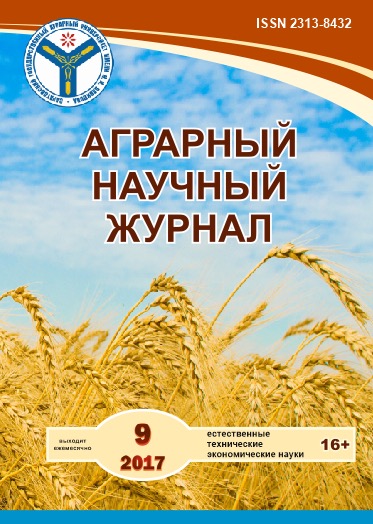AGROECOLOGICAL ASPECTS OF CHEMICALS’ APPLICATIONS TO PROTECT MILLET CROPS FROM WEEDS IN THE SARATOV RIGHT BANK
Keywords:
millet, agrotechnical methods, herbicides, fertilizer, weed plants, productivity, water regime of the soil, food regime of the soil, microbiological activity of soilAbstract
Fenizane (0.18 l / ha) and diphezan (0.17 l / ha) are the most effective herbicides against the complex of perennial and annual weeds in millet crops. Their application has significantly (by 26.2-40.5%) increased the yield of millet. The difference in moisture reserves in the experimental versions compared with the control is in the initial period of the crop development. The application of herbicides saves nutrients, especially when the crops are highly contaminated. By harvesting in plots, weeded out with herbicides, the conditions of mineral nutrition were better than in the control (5.85 mg / kg). Chemicals in optimal doses do not inhibit the development of soil bacteria, but cause only a brief inhibition, which is replaced by a “stimulating” effect.
Downloads
References
2. Васильевская Т.А., Седов В.В. Особенности роста и развития проса в Саратовской области // Специалисты АПК нового поколения: материалы 4-й Всерос. науч.-практ. конф. – Саратов: КУБиК, 2010. – С 42–44.
3. Доспехов Б.А. Методика полевого опыта. – М.: Агропромиздат, 1985. – 351 с.
4. Комплексные меры борьбы с вредными организмами, водный и пищевой режим в посевах кукурузы, овса на черноземах Поволжья / Ю.Я. Спиридонов [и др.] // Аграрный научный журнал. – 2016. – № 5. – С. 31–34.
5. Ларина Г.Е., Спиридонов Ю.Я., Шестаков В.Г. Экологические аспекты применения гербицидов на основе производных сульфонилмочевины в прополочных целях // Научно обоснованные технологии химического метода борьбы с сорняками в растениеводстве различных регионов Российской Федерации: сб. науч. ст. – Голицыно, 2001. – С. 5–29.
6. Никитин Н.В., Спиридонов Ю.Я., Шестаков В.Г. Научно-практические аспекты технологии применения современных гербицидов в растениеводстве. – М.: Печатный город, 2010. – 200 с.
7. Применение комплексных гербицидов для защиты яровой пшеницы от сорных растений в агроэкосистемах Саратовского Правобережья / Н.И. Стриж
ков [и др.] // Аграрный научный журнал. – 2016. – 6. – С. 41–46.
8. Сергеева И.В., Шевченко Е.Н., Зябирова М.М. Биоэкологический анализ сегетальной фракции флоры некоторых залежей Саратовской области // Вестник Саратовского госагроуниверситета им. Н.И. Вавилова. – 2014. – № 6. – С. 28–31.
9. Сергеева И.В., Даулетов М.А., Ахмеров Р.Р. Агроэкологические аспекты использования гербицидов в посевах озимой пшеницы // Аграрный научный журнал. – 2016. – № 1. – С. 27–32.
10. Спиридонов Ю.Я., Шестаков В.Г. Развитие отечественной гербологии на современном этапе. – М.2013. – 426 с.
11. Элементы сортовой агротехники в защите посевов пшеницы от вредных организмов на черноземах южных Саратовского Правобережья / Н.И. Стрижков [и др.] // Аграрный научный журнал. – 2015. – № 6. – С. 39–42.








